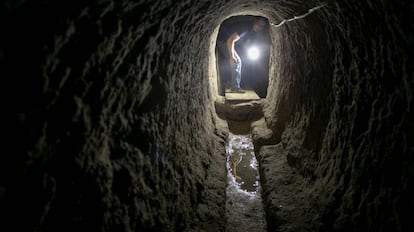The blind beetles and child slaves of Cadiz’s ancient underworld
Deep below the city is a history lesson dating back more than five millenia, complete with Roman waterways, tombs and labyrinths

Under the bustling, sunlit squares and streets of the southern city of Cadiz lies a hidden world of Roman sewers, alleyways, tombs and labyrinths – a smuggler’s paradise and a hidden maze of intrigue to fire the imagination.
But most of the time, it is a world ruled by small sightless beetles that have lived underground here for close to 6,000 years. Once thought to be extinct, they are now a protected species whose feet leave furrows as they march through tunnels that, as far back as the eighth century BCE, were a hive of human activity. Here, an alternative history has been played out, but at such a depth to prove practically inaccessible.
As befits a hidden world, it’s often hard to separate fact from myth in the tunnels of Cadiz
At the Gadir archeological site, underneath the Tía Noruca Puppet Theater in the center of the Atlantic port city, there is evidence of the daily life of Andalusia’s first settlers, the Phoenicians, who came here in the 9th century BCE. Here, from an elevated walkway, visitors can look down on their city, taking in the homes and tools they used, and even the fossilized remains of cows that wandered the streets. The site also harbors the resting place of an unknown denizen of Gadir, dubbed Mattan by archeologists, who died in a huge fire around 720 BCE. There is also an altar to healing gods as Apollo and Hygieia.
“Cadiz is a city that was founded from the East and that worshiped deities of the underworld,” says Darío Bernal of Cadiz University. “They created a gateway to the other world.”
At the nearby Casa del Obispo archeological site, by the city’s cathedral’s eastern wall, 1,500 square meters of ruins have been excavated, taking visitors on a journey from the 8th century BCE to the 1700s. Once a Phoenician funerary complex, it became the city’s Episcopal Palace in the 16th century. Opened to the public in 2006, it was closed two years ago amid a legal dispute.
Meanwhile, access to the waterways built by the Romans has for many years only been possible via private properties and the odd drain. But now, thanks to Germán Garbarino, who runs the Casa del Obispo, the public can access one of these tunnels dating back to the 3rd century BCE.
Child slaves
Six-and-a-half meters below ground, in damp air that leaves you breathless, water trickles in through holes in the rock. “Judging by the size of the holes, it looks as though child slaves were used, which fits with the height of the spaces for the lanterns,” says Garbarino as he indicates the black from the flames.
There are also water tanks from the 16th century whose color indicates the different levels of water. “Lime and red ochre pigments that formed a watertight mass were used for the tanks,” says Garbarino.
Most of the time, this is a world ruled by small sightless beetles that have lived underground here for close to 6,000 years
That’s not all. Under the city is another labyrinth of alleyways built in the 17th century that were used to move troops, before being taken over by smugglers. Known as the caves of María Moco, they were said to harbor a witch who would eat children who dared to come near her, a cautionary tale undoubtedly told to keep youngsters away from the smugglers.
Speleologist and businessman Eugenio Belgrano, who explored the length of these vaulted tunnels as a child, has put his enthusiasm for the underground world to good use and pushed for the 17th-century catacombs to be opened to the public. These can now be accessed from the center of Cadiz.
Five meters down, visitors can see silhouettes of what appear to be corpses on the walls. “This place was used as a refuge during the Spanish Civil War, and before that were possibly a meeting place for the Rosicrucians, who were linked to the masons,” says Belgrano, pointing out a drawing on the wall showing symbolism related to the order. “Many foreign masons have come to see it and now a group of experts are studying it in more detail,” says Belgrano, who has published a book about the Pozo de la Jara, the city’s only source of fresh water, and reportedly used by Christopher Columbus before setting out on his second trip to the Americas.
As befits a hidden world, it’s often hard to separate fact from myth in Cadiz. Further academic study is needed to confirm the many theories that have emerged over the centuries, while the city and regional authorities could do a lot more to shed light on this important legacy, which for the moment is largely the preserve of Cadiz’s population of millenarian beetles.
English version by Heather Galloway.
Tu suscripción se está usando en otro dispositivo
¿Quieres añadir otro usuario a tu suscripción?
Si continúas leyendo en este dispositivo, no se podrá leer en el otro.
FlechaTu suscripción se está usando en otro dispositivo y solo puedes acceder a EL PAÍS desde un dispositivo a la vez.
Si quieres compartir tu cuenta, cambia tu suscripción a la modalidad Premium, así podrás añadir otro usuario. Cada uno accederá con su propia cuenta de email, lo que os permitirá personalizar vuestra experiencia en EL PAÍS.
¿Tienes una suscripción de empresa? Accede aquí para contratar más cuentas.
En el caso de no saber quién está usando tu cuenta, te recomendamos cambiar tu contraseña aquí.
Si decides continuar compartiendo tu cuenta, este mensaje se mostrará en tu dispositivo y en el de la otra persona que está usando tu cuenta de forma indefinida, afectando a tu experiencia de lectura. Puedes consultar aquí los términos y condiciones de la suscripción digital.
More information
Archived In
Últimas noticias
From Andorra to Gibraltar, a black market for Ozempic exploits its success: ‘They’re the most sought-after products in the world’
Magnets in their heads: How some animals guide themselves using the Earth’s magnetic field
From Hungary’s Orbán to Chile’s Kast: How Trump helps turbo charge the far right
The brief rise and retreat of Generation Z in Mexico
Most viewed
- Why we lost the habit of sleeping in two segments and how that changed our sense of time
- Trump’s obsession with putting his name on everything is unprecedented in the United States
- Charles Dubouloz, mountaineering star, retires at 36 with a farewell tour inspired by Walter Bonatti
- Venezuela faces its most tense Christmas yet
- The Florida Keys tourist paradise is besieged by immigration agents: ‘We’ve never seen anything like this’











































